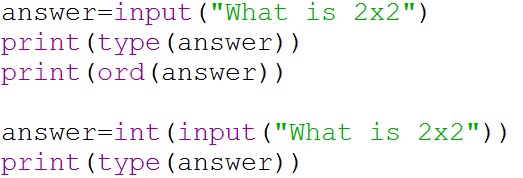 Our 1st Python program makes use of a number of new constructs and variables.
Our 1st Python program makes use of a number of new constructs and variables.
# – Internal Commentary, anything after the # on the same line is ignored by the translator
= (Assignment) – values are assigned to the variables using an equals sign.
input() – a string is captured from the keyboard using the input() function
int() – this function changes the datatype of the given variable to an integer (Whole number)
Expression – The expression is the right hand side of the =, this is evaluated and any calculations performed, the results are then assigned to the variable on the left hand side of the equals
print() – This function displays a string. The “,” is used to concatenate strings and add a space between them.


